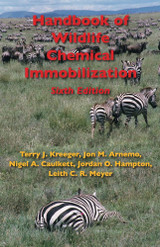Terry J. Kreeger, MS, DVM, Ph. D.
Jon M. Arnemo, DVM, Ph. D.
Nigel Caulkett
Jordan Hampton
Leith Meyer
2023 6th edition. Four-color; 72 illustrations. Drug doses for over 500 species. This is the sixth edition of the Handbook of Wildlife Chemical Immobilization. The Handbook is used worldwide and because of this international distribution, three authors have been added to the original two authors (Kreeger and Arnemo): Drs. Nigel Caulkett of Canada, Jordan Hampton of Australia, and Leith Meyer of South Africa. These highly experienced and well-published (all of us representing 193 references in the Handbook) individuals will add their regional knowledge and insights to this edition. The Handbook covers legalities of drug possession and use; types of drugs used for animal capture; equipment used for animal capture; animal capture procedures and techniques; animal medical treatment; and human emergency medicine, supported by over 2,750 references. Reviews of previous editions: 5th edition: “Kreeger and Arnemo’s latest edition is a must-have for wildlife professionals. It is user-friendly and is easy and fun to read. It addresses virtually all species one might immobilize and almost every complication that could occur. This handbook provides a quick reference for the development of wildlife chemical immobilization plans and is a recommended addition to every wildlife library (Journal of Zoo and Wildlife Medicine 2018; 49: 1064). 4th edition: “This book is coveted by wildlife professionals and written by highly respected and very experienced wildlife veterinarians. Any veterinarian or wildlife biologist working with wild species will find this book useful and should have it on their shelves” (Journal of Wildlife Diseases 2014; 50: 157). 3d edition: “ It is a ‘must have’ on the bookshelf of anyone using the technique of chemical immobilization” (Journal of Wildlife Diseases 2009; 45: 1239-1240). 2nd edition: “This book is a tremendous value for the wealth of information provided and a must-have textbook for anyone involved in the chemical capture of wildlife species” (Journal of the American Veterinary Medical Association 2003; 223: 802).

